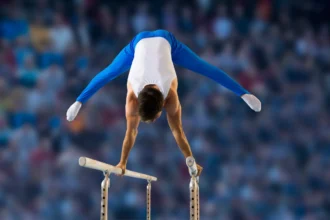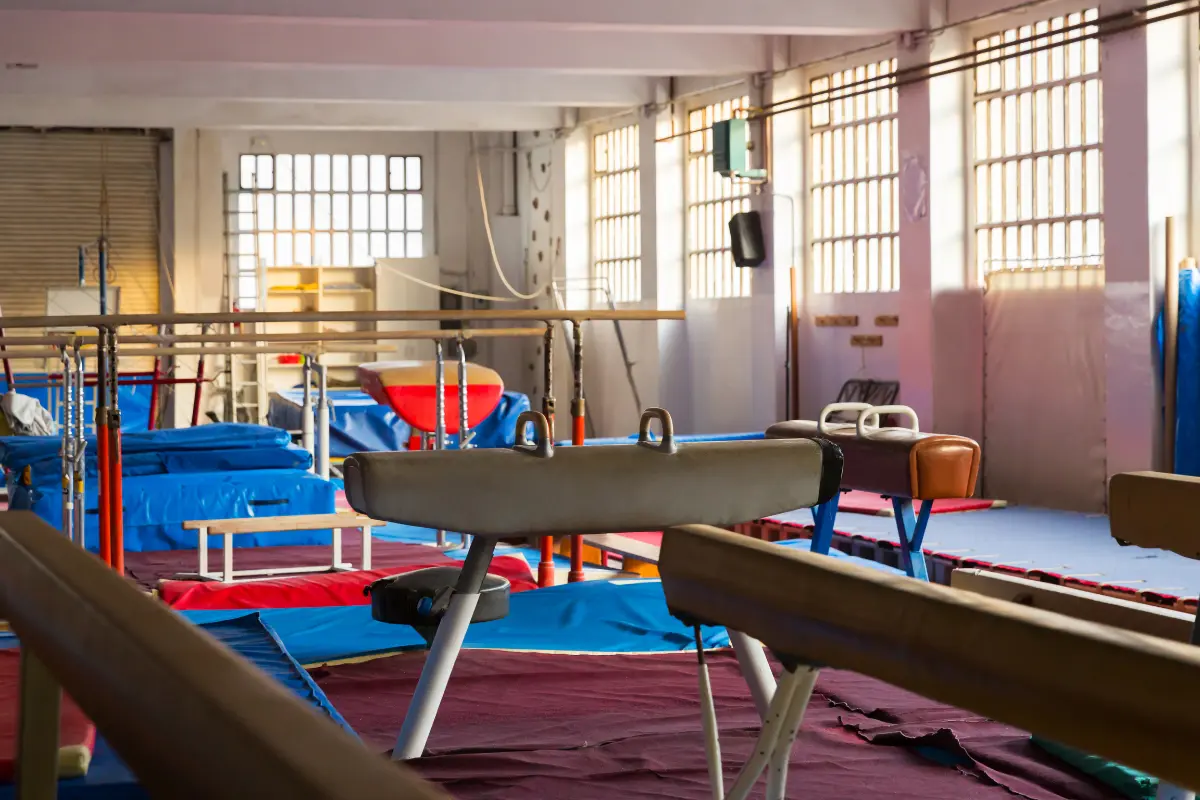Many U.S. gymnastics fans hear that “Level 10 is the top,” only to discover during the Olympics that “Elite” exists above it. Surprisingly, both statements are true, but in very different contexts. These two levels represent separate tracks within USA Gymnastics, each with its own goals, structure, and definition of success.
Two Parallel Ladders in USA Gymnastics
The Development Program is the main path for U.S. gymnasts, starting at Level 1 and going up to Level 10. Levels 6–10 use a traditional 10-point scoring system, called the Optional Code. This program focuses on national competitions—like the Development Program Nationals—and helps gymnasts get recruited for college gymnastics (NCAA).
Alongside it runs the Elite Pathway. It contains two levels: Junior Elite (usually ages 11–15) and Senior Elite (16+ for women, 18+ for men). Elite gymnasts use a different scoring system called the FIG Code of Points, which has no maximum score and rewards harder skills. Instead of college, this path leads to international meets, like the World Championships and the Olympic Games.
These two ladders operate in parallel, each with its own structure, scoring, and end goal.
| Ladder | Rungs | Scoring Code | End Goal |
|---|---|---|---|
| Development Program | Levels 1–10 | 10.0 Optional Code (2022–2026) | National titles & NCAA recruitment |
| Elite Pathway | Junior Elite → Senior Elite | FIG Code of Points (Open-ended) | World Championships & Olympic Games |
What Makes a Gymnast “Level 10”?
1. Age Range:
Most Level 10 gymnasts are 14 or older, though there’s no upper age limit. As long as the skill and scoring requirements are met, athletes can remain at this level indefinitely.
2. Skill Requirements:
To compete at Level 10, gymnasts must fulfill specific “Special Requirements” on each apparatus. Once a routine reaches a 10.0 Start Value, any additional difficulty no longer adds value. This means routines are built for clean execution rather than overloaded difficulty.
3. Mobility Rule:
Gymnasts move up to Level 10 by earning a required “mobility score” at a sanctioned meet during Level 9 competition. This ensures athletes are technically and competitively ready for the demands of the top Development level.
4. Competition Season:
The Level 10 season progresses from State Championships → Regional Championships → Development Program National Championships, typically held each spring.
5. Training Hours:
Level 10 gymnasts usually train between 20 to 24 hours per week, balancing intense practice with school and recovery.
Next Steps:
For many athletes, Level 10 is the launchpad to college gymnastics. NCAA routines also start from a 10.0, making this level the perfect foundation for recruiting and scholarship opportunities.
🔍 Because routines are capped at a 10.0 Start Value, coaches focus on perfecting execution—stuck landings, clean lines, and flawless form—rather than adding ultra-difficult skills that won’t impact the score.
Source: static.usagym.org
What Makes a Gymnast “Elite”?
1. Age Categories:
- Junior Elite: Girls ages 12–15; Boys ages 12–17
- Senior Elite: Girls age 16+; Boys age 18+
These age divisions determine eligibility for international assignments and national team selection.
2. How to Qualify:
To become Elite, gymnasts must hit a published Elite-Qualifying Score at specific events—such as a National Qualifier, Winter Cup, or U.S. Classic—each season. These scores are updated annually by USA Gymnastics and vary slightly by apparatus and age group.
3. Scoring System:
Elite gymnasts compete under the FIG Code of Points, which features an open-ended Difficulty (D) score added to a 10.0 Execution (E) score. There’s no upper limit—more risk brings the potential for higher scores, but also harsher deductions.
4. Competition Season:
Elite athletes aim for the sport’s biggest stages, with a typical progression of:
U.S. Championships → Selection Camps → World Championships and Olympic Games.
Only the best are chosen to represent the U.S. in FIG-sanctioned international events.
5. Training Load:
Elite gymnasts often train 30+ hours per week, year-round. This level demands a near-professional commitment, with many athletes attending online or hybrid school to accommodate training schedules.
🔍 In Elite gymnastics, routines aim for the hardest skills allowed, while still looking sharp and polished. It’s a challenge you don’t see at Level 10.
Source: usagym.org
Head-to-Head: Level 10 vs. Senior Elite
| Category | Level 10 | Senior Elite |
|---|---|---|
| Start Value | Capped at 10.0 | Open-ended (D-score + E-score – neutral deductions) |
| Skill Limits | Extra difficulty doesn’t increase score | Higher difficulty directly boosts the D-score |
| Minimum Age | No official minimum (typically age 14+) | Age 16+ (WAG), 18+ (MAG) for senior-level competition |
| How to Qualify | Achieve a “mobility score” at Level 9 competition | Meet published Elite Qualification Scores at select meets |
| Top Competition | Development Program Nationals | U.S. Championships, World Championships, Olympic Games |
| Judging Code | USAG Development Program Code (JO) | FIG Code of Points |
How You Qualify
Level 10: Moving Up from Level 9
To move up to Level 10, a gymnast must get the required scores at official Level 9 meets. Once she qualifies, she can stay at Level 10 for the rest of the season. There’s no special national test—just meet the score, and you’re in.
Example: In many regions, the mobility score from Level 9 to Level 10 is around 34.00–35.00 all-around (AA), though exact requirements can vary by region or event.
Elite: A Two-Part Qualification Process
Qualifying to Elite is a more selective and challenging process. Gymnasts must attend a designated National Qualifier and pass two separate scoring tests to enter the Elite ranks:
- A compulsory score (for example, 35.00 all-around for women in 2025)
- An optional routine score (like 51.00 all-around for women, or certain event scores for specialists)
These scores must be earned at the same meet (i.e., a National Qualifier), and both must be met to officially qualify as an Elite gymnast.
Can Level 10s Move to Elite—and Back?
Yes—they can!
Gymnasts can move from Level 10 to Elite, and sometimes back from Elite to Level 10.
Moving Up to Elite
Level 10 is often the starting point for future Elites. It helps gymnasts learn how to perform custom routines, build consistency, and compete under pressure, without the harder rules used in Elite. If they do well and meet the required scores at certain meets, they can qualify for Elite.
Moving Back to Level 10
Some Elite gymnasts move back to Level 10, especially if they stop doing international competitions. This is called “down-leveling.” It allows them to:
- Compete under easier rules
- Train fewer hours
- Focus on getting ready for college gymnastics (NCAA)
In short, Level 10 and Elite aren’t final stops—they’re flexible paths. Gymnasts often switch between them based on their goals, age, and lifestyle.
Conclusion
Level 10 is the highest level in the U.S. Development Program. It’s great for gymnasts who want to compete in big U.S. meets and go on to college gymnastics. Elite is a step above. It follows international rules, has no limit on difficulty, and leads to the World Championships and the Olympic Games.
Both levels are a big achievement, but Elite is the highest level in gymnastics, where gymnasts compete against the best in the world.











